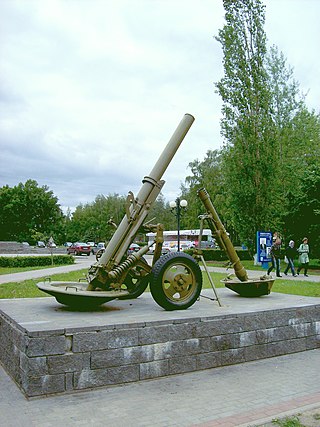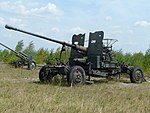
The Armed Forces of Equatorial Guinea consists of approximately 2,500 service members. The army has almost 1,400 soldiers, the navy 200 service members, and the air force about 120 members. There is also a gendarmerie, but the number of members is unknown. The Gendarmerie is a new branch of the service in which training and education is being supported by the French Military Cooperation in Equatorial Guinea. Military appointments are all reviewed by President Teodoro Obiang, and few of the native militiamen come from outside of Obiang's Mongomo-based Esangui clan. Obiang was a general when he overthrew his uncle, Francisco Macías Nguema.
The Armed Forces of Senegal consists of about 17,000 personnel in the army, air force, navy, and gendarmerie. The Senegal military force receives most of its training, equipment, and support from France and the United States. Germany also provides support but on a smaller scale.

The HQ-16 is a medium-range surface-to-air missile (SAM) from the People's Republic of China. It is derived from earlier versions of the Russian Buk missile system.

The 9M14 Malyutka is a manual command to line of sight (MCLOS) wire-guided anti-tank guided missile (ATGM) system developed in the Soviet Union. It was the first man-portable anti-tank guided missile of the Soviet Union and is probably the most widely produced ATGM of all time—with Soviet production peaking at 25,000 missiles a year during the 1960s and 1970s. In addition, copies of the missile have been manufactured under various names by at least six countries.

The 9M113 Konkurs is a Soviet SACLOS wire-guided anti-tank missile.

The Royal Army of Oman is the ground forces component of the Sultan of Oman's Armed Forces. It was founded in 1907 as the Muscat Garrison. It has a current strength of 35,000 personnel.

The B-10 recoilless rifle is a Soviet 82 mm smoothbore recoilless gun. It could be carried on the rear of a BTR-50 armoured personnel carrier. It was a development of the earlier SPG-82, and entered Soviet service during 1954. It was phased out of service in the Soviet Army in the 1960s and replaced by the SPG-9, remaining in service with parachute units at least until the 1980s. Although now obsolete it was used by many countries during the Cold War.

The OTO-Melara Mod 56 is an Italian-made 105 mm pack howitzer built and developed by OTO Melara. It fires the standard US type M1 ammunition.

The 37 mm automatic air defense gun M1939 (61-K) is a Soviet 37 mm calibre anti-aircraft gun developed during the late 1930s and used during World War II. The land-based version was replaced in Soviet service by the AZP S-60 during the 1950s. Guns of this type were successfully used throughout the Eastern Front against dive bombers and other low- and medium-altitude targets. It also had some usefulness against lightly armoured ground targets.

The Soviet 160 mm Mortar M1943 is a smoothbore breech loading heavy mortar which fired a 160 mm (6.3 in) bomb. The M1943 was one of the heaviest mortar used by Soviet troops in World War II. Around 535 of these weapons were fielded with Soviet forces during the war. It was replaced in Soviet service after World War II by the M-160 mortar of the same caliber.

AZP S-60 is a Soviet towed, road-transportable, short- to medium-range, single-barrel anti-aircraft gun from the 1950s. The gun was extensively used in Warsaw Pact, Middle Eastern and Southeast Asian countries.

The M1943 Mortar or 120-PM-43 or the 120-mm mortar Model 1943, also known as the SAMOVAR, is a Soviet 120 millimeter calibre smoothbore mortar first introduced in 1943 as a modified version of the M1938 mortar. It virtually replaced the M1938 as the standard weapon for mortar batteries in all Soviet infantry battalions by the late 1980s, though the armies of the Warsaw Pact utilised both in their forces.

The M-37 or 82-BM-37 is a Soviet 82 millimeter calibre mortar designed by B.I. Shavyrin and accepted into service in 1937. The design of the M-37 is based on the earlier French Brandt mle 27/31 mortar with Russian modifications. The main difference between the 82-PM-37 and the earlier 82-PM-36 was the adoption of a round base plate, revised traverse/elevation controls, simplified sights and spring-loaded shock absorbers on the bi-pod to reduce the amount of relaying needed between shots. It was designed to be able to fire western 81 mm captured ammunition whilst not permitting the enemy the same advantage The German designation for captured M-37 mortars was 8.2 cm GrW 274/2(r).
The Chadian Ground Forces are the main and largest component of the Chadian National Army. Historically Chad has had one of the strongest armies in the Sahara region, larger than the Malian or Central African army, with a total of 25,000 to 30,000 troops. Chad has been involved as part of the Multinational Joint Task Force in fighting the Boko Haram insurgency, deploying troops to Niger and Mali. Another common role of the Chadian Army has been quelling rebellions against the central government of Chad.
The Zambian Army is the land military branch of the Zambian Defence Force. Like all branches of the Zambian military, citizens of the nation are required to register at 16 years old, and citizens can join at 16 years old with parental consent or at 18 years old when they are classified as adults by Zambia. There is currently no conscription. Applicants must be Zambian citizens and must have a school Grade 12 certification. Applicants must also undergo a test for HIV on enlistment. Personnel can serve until age 55, when there is a mandatory retirement. Its first Commander Major General was Michael Grigg, appointed by Kenneth Kaunda. The first local Commander was Gen Kingsley Chinkuli. According to the 2014 CIA World Factbook: The current National Army Commander is Lieutenant General Geoffrey Choongo Zyeele and his deputy is Major General Luswepo Sinyinzawho who were both appointed by President Hakainder Hichilema on 12 September 2024.

















































